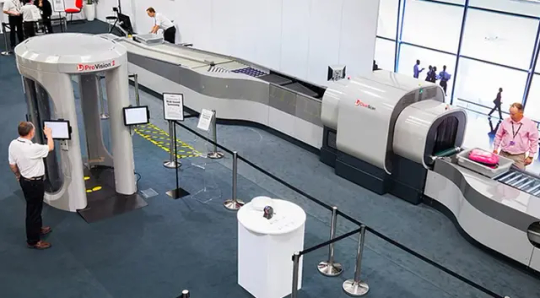#SecurityScreeningMarket
Explore tagged Tumblr posts
Text
Security Screening Market Drivers Boosting Demand Across Airports, Borders, and Public Infrastructure Globally
The security screening market has witnessed substantial growth over the past decade, fueled by increasing global threats, regulatory reforms, and technological innovation. Governments, private enterprises, and transport authorities are prioritizing safety and investing heavily in advanced screening systems to ensure the protection of people, assets, and national infrastructure.

With the rising need for effective threat detection and risk mitigation, several key market drivers are influencing the expansion and evolution of security screening systems. From airport checkpoints and public venues to border control and critical facilities, security screening is no longer optional—it is essential.
Heightened Threat of Terrorism and Criminal Activities
One of the most influential drivers of the security screening market is the persistent threat of terrorism and organized crime. High-profile attacks at airports, stadiums, metro stations, and government buildings over the past two decades have elevated public and political pressure to strengthen preventive measures.
Security screening technologies such as full-body scanners, X-ray systems, metal detectors, and explosive trace detectors are essential for detecting weapons, explosives, contraband, and other dangerous items. As threats become more sophisticated, governments and organizations are increasingly compelled to invest in equally advanced detection capabilities to safeguard the public and deter unlawful activity.
Stringent Government Regulations and Safety Protocols
National and international safety regulations play a pivotal role in driving the security screening market. Authorities such as the Transportation Security Administration (TSA), European Civil Aviation Conference (ECAC), and other global agencies have established strict screening protocols for airports, seaports, and other high-traffic transit hubs.
These regulations mandate the deployment of specific technologies and screening procedures to ensure the detection of prohibited items. As regulatory frameworks evolve to address emerging threats, the demand for compliant, up-to-date screening systems continues to rise. Service providers and equipment manufacturers benefit from consistent demand generated by policy-driven upgrades and replacements.
Increasing Passenger and Cargo Traffic
The rise in global travel and cargo movement is another major growth driver. Airports, railway terminals, and shipping ports are seeing increased footfall and freight volumes, putting pressure on infrastructure and security systems.
To maintain operational efficiency without compromising safety, transport hubs are investing in high-throughput security screening systems that can rapidly inspect large volumes of passengers, baggage, and cargo. Automated lanes, AI-powered screening algorithms, and CT scanning technologies are being adopted to enhance both speed and accuracy.
The growth in international trade also amplifies the need for robust cargo screening to detect illegal items, drugs, and biological threats hidden in shipping containers or freight packages.
Technological Advancements and Smart Screening Solutions
Rapid technological advancement is reshaping the security screening market. Traditional detection methods are being complemented—and in some cases replaced—by more intelligent, efficient, and accurate technologies. Artificial intelligence, machine learning, facial recognition, and biometric verification are being integrated into modern screening solutions.
These innovations enhance threat detection while reducing human error and streamlining passenger flow. Smart systems can automatically flag suspicious items or behaviors, freeing human operators to focus on higher-level decision-making. The trend toward contactless and remote screening has also gained momentum, particularly in response to global health concerns and the need to minimize physical contact.
Urbanization and Expansion of Public Infrastructure
As cities grow and urbanization accelerates, there is a corresponding increase in demand for public security. Stadiums, government buildings, transportation networks, corporate campuses, and educational institutions all require security screening measures to prevent incidents and reassure the public.
Large-scale events—such as political summits, international sports competitions, and cultural festivals—often implement temporary but sophisticated screening systems to protect attendees and participants. This expanding application of security screening beyond traditional settings contributes significantly to the market’s continued growth.
Rising Security Budgets and National Investments
Governments across the globe are allocating higher budgets to security and defense, further driving the demand for advanced screening technologies. Many countries are upgrading their border security systems, port facilities, and public transportation infrastructure as part of broader national safety initiatives.
This increased funding is creating a favorable environment for innovation and the widespread deployment of cutting-edge screening solutions. Private sector entities, especially in high-risk industries like energy and finance, are also following suit by enhancing their internal security protocols with the latest screening technologies.
Demand for Integrated and Scalable Solutions
Modern security screening is no longer about standalone devices. Organizations now seek integrated solutions that combine physical equipment, software platforms, and data analytics into a unified security ecosystem. This approach allows for centralized monitoring, real-time threat assessment, and seamless information sharing across agencies and departments.
Scalable solutions that can adapt to changing security needs and expanding infrastructure are especially popular among large transportation hubs and border agencies. This integrated, flexible approach is helping redefine the standard for modern security operations.
Conclusion
The growth of the security screening market is being powered by a complex mix of global threats, regulatory imperatives, technological progress, and infrastructural expansion. As the need for comprehensive, intelligent security systems continues to rise, stakeholders in both the public and private sectors are investing in future-ready solutions that combine speed, accuracy, and adaptability. With continued innovation and government support, the security screening market is set to remain a crucial pillar of global safety infrastructure in the years to come.
0 notes